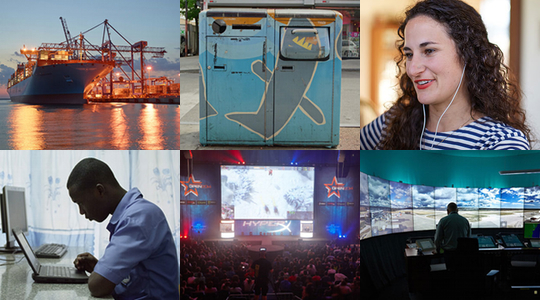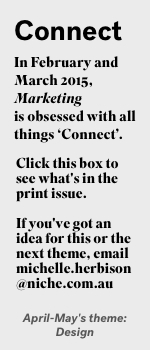Capturing the networked society: behind the Ericsson documentary project that spans 25 countries
Share

 Fredrik Magnusson, director of brand design and experience at Ericsson, talks through the telecom infrastructure brand’s ambitious documentary content marketing project, including taking cues from the automotive industry, targeting future customers and how “really, really boring” infrastructure can be inspiring.
Fredrik Magnusson, director of brand design and experience at Ericsson, talks through the telecom infrastructure brand’s ambitious documentary content marketing project, including taking cues from the automotive industry, targeting future customers and how “really, really boring” infrastructure can be inspiring.
Ericsson has been involved in telecommunications since 1876. In that context the brand’s exit from mobile phone handsets in 2011 is very recent history, but that’s the issue: everyone still knows the name, but how many people know what it does today?
Marketing spoke to Ericsson director of brand design and experience, Fredrik Magnusson, about a content project designed to illustrate the answer to that question.
And there’s a big story to tell when you dig into Ericsson’s behind-the-scenes role. 41% of all mobile traffic in the world runs through networks built or run by Ericsson, and the software development that goes behind world-wide mobile infrastructure makes it the the world’s fourth largest software manufacturer.
‘Capturing the Networked Society’ is a documentary project that saw Ericsson and its Stockholm-based agency House of Radon visit 25 countries to meet with and document real-life ‘change-makers’. From the beaches of Cape Town to the mountains of Greenland and the streets of LA, all cases are housed in an interactive website, where each frame has a story ready to be explored.
Marketing: 25 countries, 61 stories, sounds like a big project. What’s the goal?
Fredrik Magnusson: We have a couple of challenges as a company. Most people know Ericsson from the fact that we used to do cellphones, but we don’t anymore, so people don’t really know what we do. In order to explain what we do, we need to exemplify.
In trying to exemplify what we do, you could either describe the infrastructure, which is really, really boring and uninspiring and it doesn’t tell people the benefit of a networked society.
Everything people do will change when you have the connection. In order to make people understand what our role is in that, we can’t say, ‘This is an antenna. This is the software that runs your system.’ People aren’t interested.
What we need to say is, ‘All this is possible when you transform your industry with the help of mobility.’
What we decided to do was exemplify where the future is heading. If you look at the automotive industry, every year they release a new concept car saying, ‘This is what the car will do five years from now, or this is what the car will do 10 years from now.’
That was where I started [but] the evolution and the transformation rate in our industry is so fast that I realised that no matter what I can come up with that is possible today or tomorrow, it’s probably already been done.
Instead of inventing it ourselves, let’s see what people do already when they add mobility to any industry. That’s what we did.
Instead, we gave ourselves a set of rules: Let’s use 100% pure documentary. Let’s not guide anyone, let’s just see what are the best cases we can find today of someone that has taken an industry, or an idea or something, added mobility, and transformed their industry.
M: So you ended up with 61 stories – were you surprised by any of them?
FM: No, I think what’s interesting is the spread. A couple of extremes.
You have the one case, she makes a living out of taking a photograph of her breakfast sandwich every day. She lives in a small city in Norway. Her target group is definitely not in Norway. She’s living off Instagram, so just by adding a connection to her breakfast sandwich, she can make a living out of it. That’s on the very human side of it.
Then you have, of course, the extreme other end where you have remote flight services where you can land planes remotely instead of having an air tower control at the airport. You can land any plane from anywhere in the world. That’s of course a very, very different take on where mobility can become a safety issue. It can become a redundancy, it can become insurance.
You have everything from things that impact just the normal individual to things that impact the entire society. I think we have the complete span of that.
M: I imagine that’s very different to what you could have come up with going down the other, non-documentary route.
FM: It probably would have been very different. I also think that it brought a completely different level of credibility to it, because this is not us saying what will happen, this is people using mobile technology today to prove the informational aspects of mobility. It’s already happening today.
What we demand from our target audience is, instead of saying what the future will be, we’re waking people up and saying, ‘Look what is already happening. You better sharpen up if you want to be part of this.’
One of the things that we really want to do here was to build a sense of urgency. When you’ve watched a couple of them, if you’re an industry leader, or if you’re an entrepreneur, or if you’re working in the government somewhere, we want people to realise that the mobility train is leaving the station.
M: What’s the primary audience for this project?
FM: This is interesting. Ericsson’s customers today are basically less than 400, and I think we have 200 giant customers today. Technically, if I wanted to sell more to my existing customers, the most efficient thing would be to actually call them, or go there, or have a discussion.
When we build brand, we cannot only look at our existing customers, we need to look at our future customers that we don’t have. Looking at the enormous transformational power that mobility has, we have to reach out into every aspect of society. We have to reach out to new industries that we haven’t even thought of could benefit from mobility. We need to raise awareness far from our comfort zone.
Another target group that we need to aim for is students and talent. Everybody’s major point in building a brand today is to be able to recruit the best talent without having to overpay for it. The more attractive your company looks, the easier it is to get the talent. One of the target groups here, other than the new industries, is definitely new talent.
Of course we’re having dialogs to deepened our business with existing customers, but this specific set of assets has been developed to reach further up into society, to students, to talent, and a little bit to normal people to prepare them for what’s about to happen, and make sure that there’s awareness of Ericsson on a greater level, in general society.
M: When you talk about looking to the future of the networked society, how far in advance are you looking? Are you looking at the next five years, the next 10 years?
FM: Right now our internal plan is 2020 when it comes to how we plan our things. It’s a natural five year plan ahead.
In terms of Ericsson as a company, we look very, very far ahead. The research teams are way further ahead than that.
Of course we have long-term technology road maps. These are big infrastructure aspects of mobility, so from the technical point of view we can’t have as short as five years, that’s much longer. In terms of communication, we have three to five year plans.
M: How are you measuring the impact of this project?
FM: A couple of things. Of course we have a set of KPIs in terms of traction, the classic ones, how many likes, and hits, and views, and how much discussion do we get. Those KPIs are the easy ones, and we set fairly aggressive KPIs to reach within six months. We reached all of them within two months.
Then the traction is different. There we have to be a little bit more qualitative. That’s how many new discussions we start, how many new companies or people are actually interested in contacting us, saying, ‘I’m coming from this industry, what can you do?’
What we’re seeing is much more frequent reach-out from entrepreneurs saying they want to learn more, to be a part.
We’re seeing that we have reached out very well to the audiences that we have missed before, so we are getting traction much more in the entrepreneur and tech innovator scene than we had before.
M: How long has Ericsson been doing branded content, or content marketing? Is this a first one?
FM: This is the first big one. At least since we let go of the phone side, we haven’t been doing anything really that reaches broader than our existing customer base.
As a big tech company, we love to talk about our radio base stations, or our OSF/BSF software that internally everybody knows what it is, but nobody cares about outside.
This is the first time we’ve started to talk about the benefits of what we do: the benefits for society, the benefits for business, the benefits for people.
That’s achieving quite a lot of traction, that we’ve changed away from tech to benefit and opportunities and possibilities.
M: Is this project something that you’ll evolve into further iterations?
FM: I think, without saying too much, if this was us looking at what the world is doing on mobile technology today, maybe in future iterations would be us playing with the industry in a different way. [That is,] if this was the observation round, next round might be more that we evolve, and play, and provoke a little bit more. This was observing, and I think the next step is going to be a little bit more dialogue.















